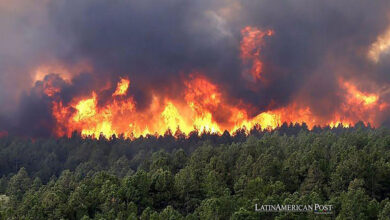Financing State Of Nature In 2022: Investments Will Have To Double By 2025
The continued loss of nature has become a systemic risk for the global economy. A new Nature Economy report found that GDP depends on nature in more than half the world.

Photo: Freepik
LatinAmerican Post | María Claudia Ramírez Pupo
Listen to this article
Leer en español: Estado de financiación de la naturaleza en 2022: las inversiones tendrán que doblarse a 2025
Nature needs more funding. That conclusion was reached by the experts of the most recent report "The state of financing for nature" of the United Nations Environment Program (UNEP). Currently, nature-based solutions (NbS) receive a monetary contribution of US$ 154,000 million per year. However, the study reveals that by 2025, "investments in NbS must be rapidly increased by up to US$ 384,000 million per year." To this end, it is stated that "the private sector must significantly increase the current amounts of investment by US$ 26,000 million per year, that is, 17% more" to deal with negative flows for nature.
Juan Camilo Villegas, professor, and researcher at the Environmental School of the University of Antioquia, Colombia, points out that NBS regulates the very functioning of nature to solve problems, such as climate change, guaranteeing water security, fertility of the soil, threats from natural disasters. In addition, they allow actions to be taken to conserve biodiversity. Additionally, he adds that " negative flows for nature are the consequence of human actions in which our extraction of materials and energy from the earth system and its ecosystems too, for example, guarantee the production and consumption of economic goods, produce imbalances in the amounts of matter and energy that circulate through ecosystems, unbalancing their functioning. A concrete example of this is the global distribution of mammalian biomass."
According to Villegas, about 83% of the biomass corresponding to wild mammals has been lost, while 96% of the biomass of mammals has been concentrated in livestock for human consumption, and the biomass of human beings themselves, distributed as follows: " 60% of the mammalian biomass is livestock and 36% is human biomass. This being the case, growth and human activities represent a detriment of resources and energy for the functioning of nature and, therefore, are the main responsible for the biodiversity crisis.
We recommend you read: World Bank and climate finance: an open wound
"Currently, governments provide 83% of investment flows in nature-based solutions (NBS); however, it is unlikely that they will decide to dramatically increase these flows due to fiscal challenges related to conflict, debt, and poverty (…)”, according to the UN Added to this is the urgency of reducing and eliminating greenhouse gas (GHG) emissions, restoring degraded land and marine environments and changing the course of biodiversity loss.
Along the same lines, the authors of the report point out that decarbonizing energy systems and eliminating the uncontrolled use of coal will not be enough if they are not complemented with considerable investments, detailing four ways to achieve it with the support of the private sector: "first, increase investments in sustainable supply chains; second, reduce activities with a negative impact on climate and biodiversity and offset unavoidable impacts through high-integrity natural markets; third, pay for the ecosystem services you use, and finally, invest in nature-positive activities."
Likewise, Inger Andersen, executive director of UNEP, points out that "(…) this requires governments, companies, and finance to massively increase investments in nature-based solutions because investments in nature allow us to secure the future of generations coming". And he adds: “The scientific data does not give rise to doubts. As we transition to net-zero emissions by 2050, we must also redirect all human activities to relieve pressure on the natural world on which we depend."
Nature is the most robust investment option and essential to increase economic resilience and human well-being. The report is a call to action to double funding for nature between now and 2025
UN
The United Nations Conference on Climate Change (COP27) was recently held, where the countries most affected and vulnerable by the loss of biodiversity and the climate change crisis managed to call on the international community to act immediately because the time does not wait and the negative effects on the health of the planet and those who inhabit it are becoming more noticeable.
During this meeting, some striking proposals from Latin American countries were launched, such as the creation of a "big bloc" that would seek to protect and restore the Amazon rainforest. It should be remembered that in the latest report "Living Planet 2022" from the World Wide Fund for Nature (WWF) which refers to the state of health of biodiversity on the planet between 1970 and 2018, experts showed that the Amazon continues to be the most affected territory, given that deforestation rates continue to increase: “We have already lost 17% of the original extension of the forests, and another 17% is degraded. The latest research indicates that we are rapidly approaching the point of no return (…)”. Likewise, Latin America had the greatest decline in the population abundance of marine and terrestrial species, with a decrease of 94%, followed by Africa (66%), Asia (55%), and Europe (18%), concludes the report of the WWF.
Another important scenario for biodiversity was the United Nations Conference on Biological Diversity (COP15). In this meeting, delegates from 196 countries met to seek to stop the mass extinction of species and ecosystems that provide benefits to human beings such as food and water security, energy, climate regulation, waste decomposition, crop pollination, and carbon capture, among others.
For its part, the World Economic Forum (WEF) estimates that "nature-positive policies could attract US$10.1 billion and create 395 million jobs by 2030." This confirms that the UN report is significantly eloquent because it speaks of a large investment, but that, over time, it will be reflected in the economy of the countries, since "nature sustains many economies." However, if the solutions used do not follow the line of the transition of economic activity but rather investment flows with a negative impact on nature, then the "darkest picture" would be seen, as mentioned by the WEF.




